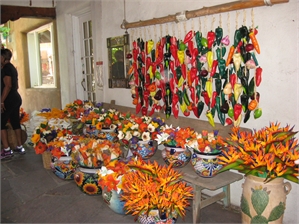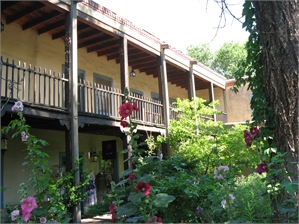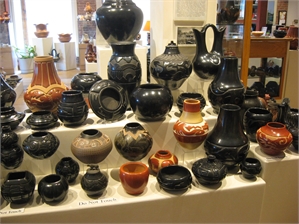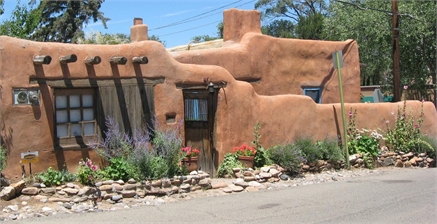Discovering Santa Fe, New Mexico
We’d planned the trip to begin with a taxi ride to Union Station for a 6:00 p.m. overnight train to Albuquerque. We hadn’t left the station and the trip was fulfilling on our film noir fantasies. With AMTRAK and Metrorail now using it, the station was bustling with commuters and travelers. We’d booked a roomette for two and after being welcomed aboard by a friendly porter, we settled in enjoying the on time departure and ride through the outskirts of Los Angeles.
We enjoyed our dining car dinner paired with a couple who were touring the entire country via train. The evening ended with the porter converting our seats to comfortable bunks as we rattled along the rails lulled gently to sleep. Waking early, there was no doubt that we were now in the fabled southwest as the expansive scenery sped by. Shortly after breakfast, we pulled into Albuquerque and leisurely drive to our destination.

Arriving in Santa Fe, we soon discovered that Pueblo-style architecture takes on an entirely new meaning when experienced in this city. Long ago its city fathers (and mothers) realized that part of its unique appeal was its Native American heritage, beautiful desert surroundings and influence in the founding and settling of the American West.
In 1912, when the town had only 5,000 people, the city’s civic leaders designed and enacted a sophisticated city plan that incorporated elements of the City Beautiful movement, the city planning movement, and the German historic preservation movement. It anticipated limited future growth, considered the scarcity of water, and recognized the future prospects of suburban development on the outskirts. The planners foresaw conflicts between preservationists and scientific planners. They set forth the principle that historic streets and structures be preserved and that new development must be harmonious with the city’s character.

Santa Fe’s Native American origins go back to as early as 1050. Five hundred years later it would be declared a province of New Spain. In 1610, it became the provincial capital making it the oldest state capital in the United States. It’s rough and tumble history saw the city move from Spanish to Mexican rule, annexed by the Republic of Texas in 1836 and briefly few the Confederate flag in 1862. It became a U.S. territory and then in 1912 admitted to the Union.
An important link to Western expansion, the Santa Fe Trail was a crossroads for settlers moving west. Santa Fe was originally envisioned as an important stop on the Atchison, Topeka and Santa Fe Railway. But as the tracks progressed into New Mexico, the civil engineers decided that it was more practical to go through Lamy, a town in Santa Fe County to the south of Santa Fe.
When the mainline of the railroad bypassed Santa Fe, it lost population. However artists and writers, as well as retirees, were attracted to the cultural richness of the area, the beauty of the landscapes and its dry climate. Local leaders began promoting the city as a tourist attraction. The city sponsored architectural restoration projects and erected new buildings according to traditional techniques and styles, thus creating the “Santa Fe style”. Edgar L. Hewett, founder and first director of the School of American Research and the Museum of New Mexico in Santa Fe, was a leading promoter. He began the Santa Fe Fiesta in 1919 and the Southwest Indian Fair in 1922 (now known as the Indian Market).

Santa Fe’s homage to its Pueblo Native American roots is undeniable. The romance of the Southwest, its climate and allure has attracted and kept artists at the heart of its community life for nearly 100 years. The city even has its own “Walk of Fame”-noted artists who lived and worked in Santa Fe is embedded in the sidewalk outside of its art museum.
New Mexico has been one of Hollywood’s favorite locations since the early days of filmmaking. While Albuquerque is its center, Santa Fe is at its heart. Many of Hollywood’s elite have settled here including actress Shirley McLaine. Oscar-winning, film legend Greer Garson knew that New Mexico was more than a pretty postcard: It’s a filmmakers’ paradise when it comes to an endless variety of locations, amazing geography and great services. And, to jump start a growing demand for working sound stages, she funded Garson Studios on the campus of the Santa Fe University of Art and Design.

Early filmmakers discovered New Mexico and such early film luminaries as D.W. Griffith, Mary Pickford and Mack Sennett created one-reel “flickers” as early as a century ago. “Crazy Heart,” “Do You Know the Millers?”, “Milagros Beanfield,” “Iron Man 2” and the new series Manhattan are just a few recent projects filmed in and around Santa Fe. New Mexico’s 30% tax credit sweetens the pie to ensure that this longstanding tradition continues.
Today all these influences meld into a style and ambiance that’s enjoyed by visitors and residents alike. Proud of their roots, their chilies, art and cuisine, “Santa Fe style” means more than architecture. Cuisine is Santa Fe’s middle name and with over 400 restaurants in the city you can be assured that there’s something for everyone’s palette. When ordering Southwest, “red or green” is the perrenial question-chili that is. Often the answer is “Christmas” a combination of the two. New Mexican is not Mexican-style but more a combination of the cultures that shaped this region-Native, Spanish and Anglo. Its emphasis on international is as much part of its cuisine as it is it’s annual folk art festival.

While downtown Santa Fe caters to its tourist population, it’s still THE place to gather. Once the original art colony, Canyon Road offers one of the country’s highest concentration of art galleries showing Southwestern, contemporary art and sculpture. Nearby the newly refigured Railyard Arts District is a feast of contemporary art and cuisine and its farmers market a weekly must do.
Venerable hotels such as La Fonda or Hotel Santa Fe are favorites as are a host of smaller properties and B&B’s. The town is definitely walkable and a free shuttle is provided that connects the town and its cultural sites.
The list of what to see and do in Santa Fe kept us on the move for three full days. The Georgia O’Keefe Museum and Santa Fe Art Museum filled an entire afternoon. A walking tour of the town one morning followed with Museum Hill’s outstanding Folk Art and Native American Art Museums. Santa Fe’s International Folk Art Festival attracts aficionados worldwide. A trip to these museums is unforgettable. Next on the list was browsing in the towns shops and authentic Indian Market adjacent to the town square. Taking out time for a traditional breakfast at the Old Plaza Café and sampling Santa Fe’s restaurant scene with stops for a signature Smoky Sage Margaritas at El Secreto Bar at the St. Francis Hotel, sadly too soon it was time to say “adios” to Old Santa Fe.
Recently named one of the 10 best cities in the United States, Santa Fe offers more than its architecture and galleries. Almost everyone you talk to comments on the spirit of the place, an intangible magnetic force that brings visitors year after year and inspire those fortunate enough to call Santa Fe “home” who continue to celebrate and preserve its rich legacy.